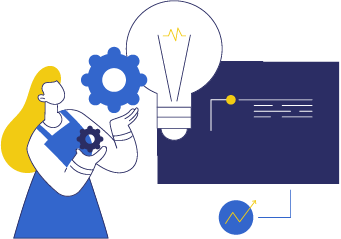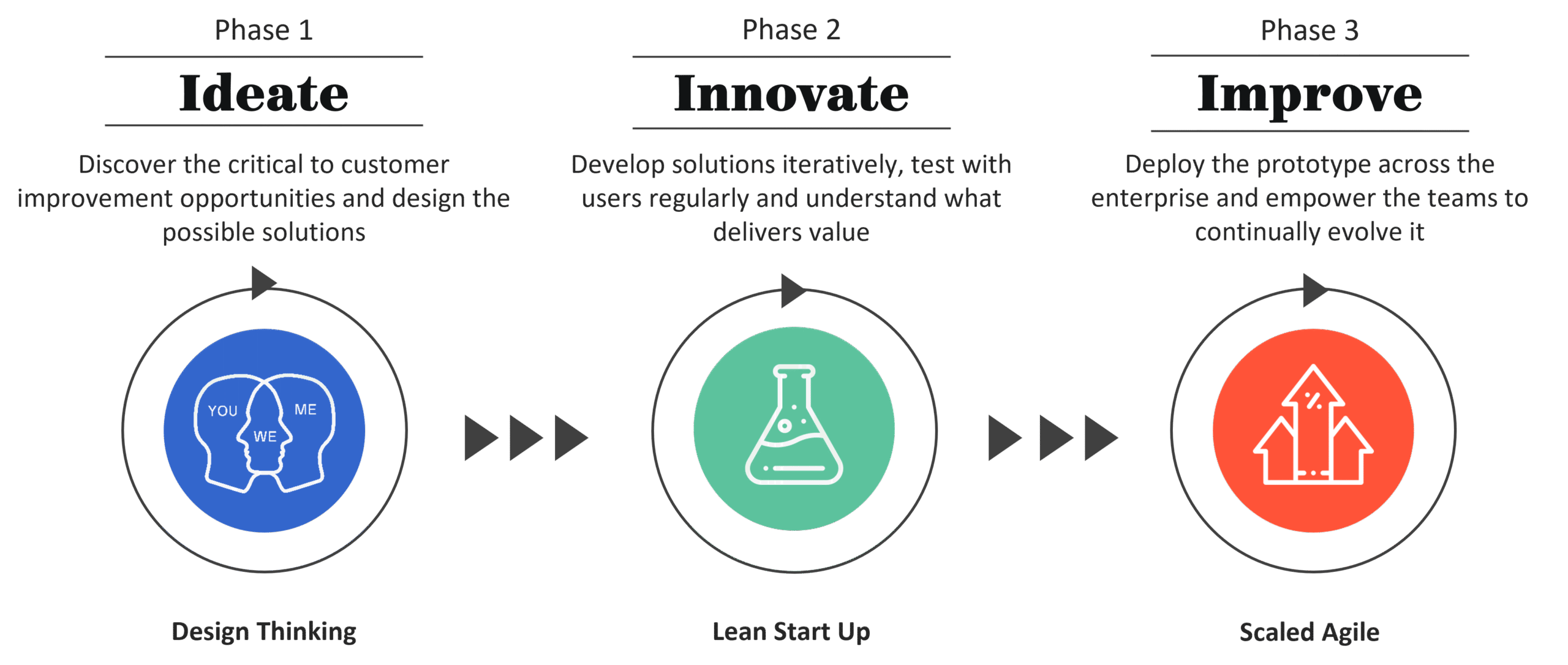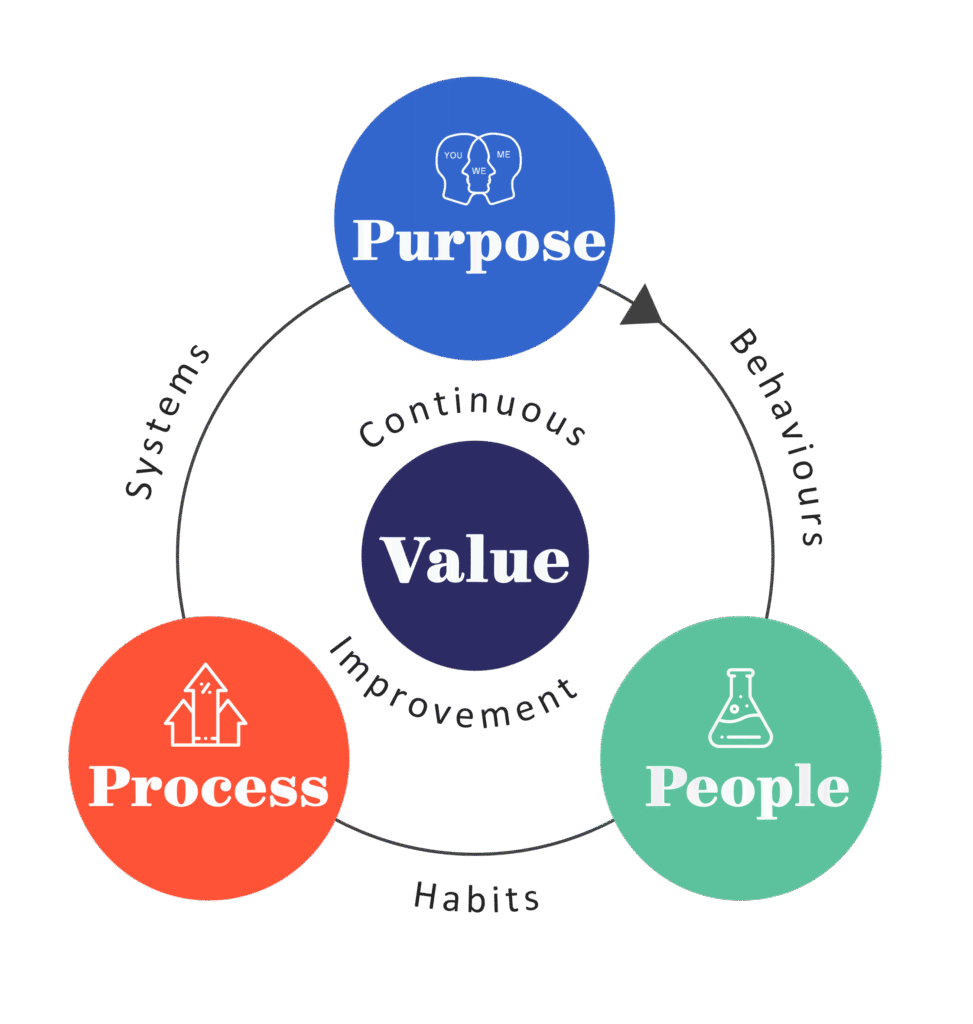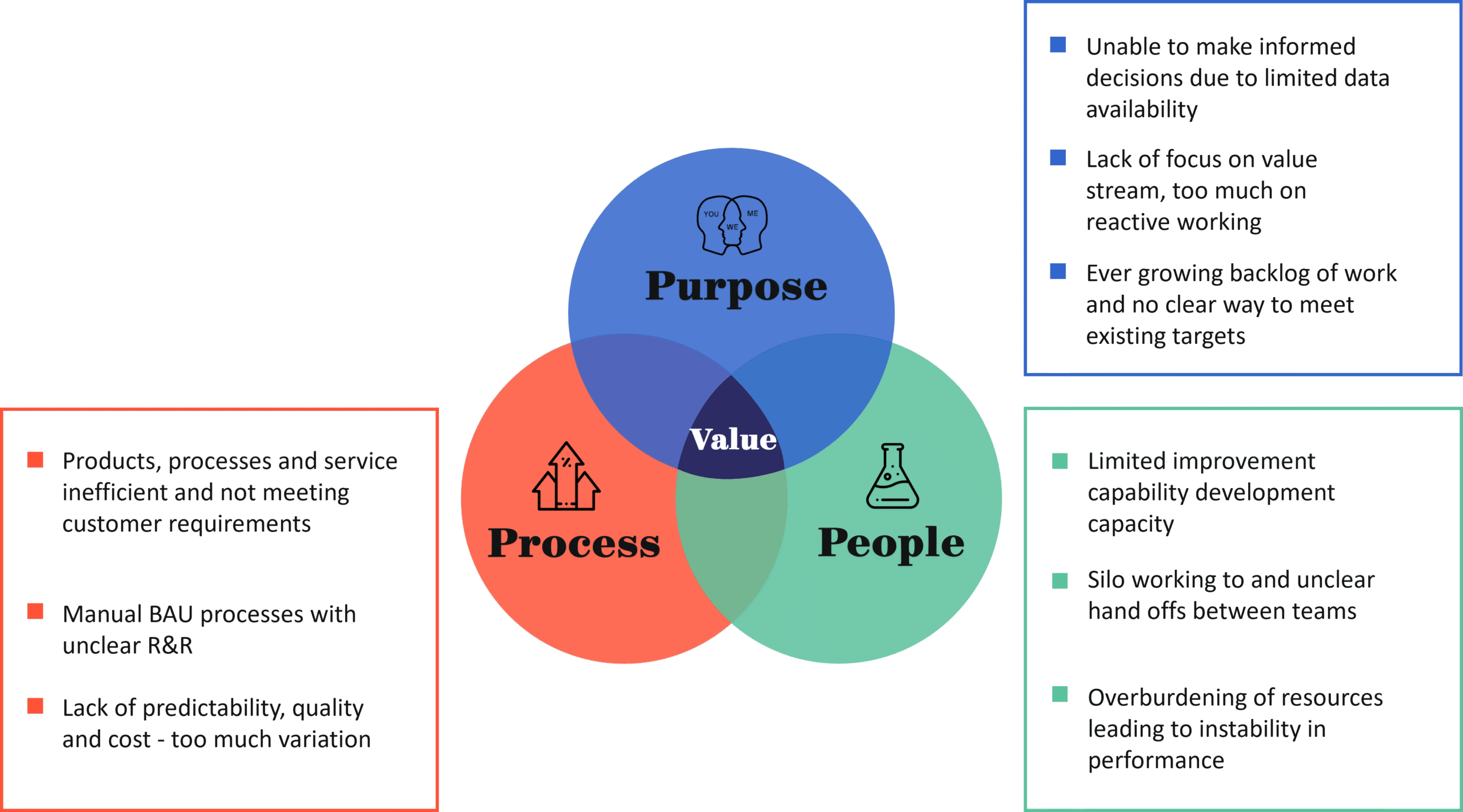
Our website is not supported on this browser
The browser you are using (Internet Explorer) cannot display our content.
Please come back on a more recent browser to have the best experience possible

Guide

Innovation might seem like a trendy buzzword dominating business conversations today, but it's far from a new concept. In the 1990’s, companies embraced Business Process Improvement initiatives, applying concepts of Innovation to improve productivity, reduce costs, and enhance value in response to fierce competition, emerging enterprise technologies, and the rise of the Internet.
Today, the situation feels strikingly similar, but with even more urgency. As disruptions increase and the pace of technological development accelerates, organisations are once again focused on adding value while cutting costs, all while trying to keep up with the relentless advancements in digital technologies, artificial intelligence, and the Internet of Things.
Innovation is the deliberate act of changing outcomes and developing solutions to meet old and new challenges. However, it goes beyond just ideas, technology, and new products and services. It is the outcome of creative, strategic, technological, commercial, and cultural processes.
Enter Lean Innovation, a radical approach to prioritising the right innovations, whether to a product or process, to derive more value for customers with less cost and risk to the organisation. It’s a proven formula for re-engineering the way work is done to better meet the needs of the future.
In addressing the question of what is Lean Innovation? or what is Lean Process Improvement? it isn’t just ‘Lean Six Sigma’. While Lean Six Sigma is a proven business improvement methodology, Lean Innovation, on the other hand, is a framework. It’s a mindset really, blending the core principles, tools and techniques from Design Thinking, Lean Startup, and Agile, into a catalyst to accelerate an organisation’s portfolio and innovation goals.

At MIGSO-PCUBED, we define Lean Innovation, also referred to as Lean Process Improvement, as an end-to-end solution that delivers rapid innovation by continuously re-engineering processes, products, or services to reduce waste, optimise performance, and maximise value.
The Lean Innovation Framework, underpinned by Change Management principles, first allows an organisation to identify new improvement opportunities aligned to the needs of the end user using Design Thinking and Lean Six Sigma problem solving. MIGSO-PCUBED will enable you to develop your strategy by focusing on each element of the business model and the types of innovation & outcomes you desire.
Second, it provides an approach for rapidly developing and iteratively testing solutions using Lean Startup and Agile ways of working. And finally, for those solutions best aligned to the organisation’s strategy, it utilises Agile for scaling continuous innovation out to the organisation in bite sized increments.

The key benefit is its straightforward methodology where employees are engaged to use their skills and motivation to improve the business - the person doing the job knows it best. Teams begin with identifying a minimum viable product, i.e. the smallest number of features that will deliver what the end customer really needs and wants. Then the team quickly tests those assumptions in experiments designed to solve a problem with the least amount of investment required. This allows the team to learn early on that the end opportunity will provide value before scaling the additional investment needed to go to market.
Think Big, Start Small, and Adapt Fast.
However, Lean Innovation is not only focused on existing products or business model innovations. In order to get the right products to market faster (i.e. step one in Design Thinking) you also need to focus on people-based innovation and process-based innovation. Organisations need to harness their people, their processes, and their purpose to provide a better customer experience.
Lean Innovation draws upon employees’ insights and empowers those closest to the work to deliver the innovations. Champions are nominated to support and drive the improvement process to deliver the organisation’s strategic purpose. These champions are trained in our Lean Innovation methodology allowing the organisation to build an in-house improvement capability.

Purpose | People | Process |
|---|---|---|
Alignment on the biggest, most impactful improvement opportunities | Build in-house improvement capability | Increase of value-added activities and removal of waste |
Clear line of sight between improvement projects and the value an organisation aims to deliver | Cadre of change champions/ agents | Sustainable transformation, data visualisation and process improvement |
Scalable value driven improvement framework | Commitment for change to a collective vision | Visible portfolio performance data enabling faster decision making |
Alignment & understanding of customer and business requirements | Foundation and roadmap for automated digital solutions |
While there is tremendous value in kicking off a Lean Innovation Transformation, there are also several common blockers organisations face when embarking on this journey. According to the ScienceDirect article on Lean Innovation Management, “Innovation management needs not only a vision and a strategy, but also the appropriate processes to implement innovation, and organisational conditions to facilitate… their implementation.”
We see four main challenges faced in implementing Lean Innovation:
There are many additional challenges faced, as depicted in the graphic below, however the majority of them are interrelated. Fixing one, often has a knock on effect to improving another.

It's therefore probably best to think along the lines of a dial or slider. How digital do we need to be within this organization in order to increase visibility of status? How Agile do we need to be in order to increase confidence in delivery? How traditional do we need to be in order to ensure compliance to regulatory requirements? Essentially, do we need to turn up the volume or turn it down to get the team to perform the best?
We see the trend of the PMO being the driver of increasing capability and value delivery within the organization. Does your Project Management Office do this for your organization?
In the first challenge, knowing the right opportunities to invest in, the unfortunate situation is that there is no shortage of ideas on where to improve. With an ever-growing backlog of work, resources are overburdened often leading to poor performance. Recently P&G published a case study on their own Lean Innovation Transformation. In the case study, they say one of the keys to their success was the ability to use data to tell them which areas to fund.
With the advent of Industry 4.0, organisations find themselves with increasing amounts of data. However, extracting value from such vast data lakes requires the development of new internal capabilities and the adoption of new technical solutions.
With Lean Innovation, we typically develop a visual management board to show in real-time the programme, the process, and the progress of the improvement. The live and accurate data enables informed management decisions and can visually highlight team performance.
The second challenge of implementing Lean Innovation is that many project teams are spending the majority of their day performing manual tasks and reactive work. Over 40% of workers say they spend a third of their week on repetitive tasks. As such, teams have a reduced opportunity to concentrate on activities that contribute or align to furthering the company’s strategic vision.
Lean Innovation looks to promote a focus on value and the elimination of waste. Teams investigate ways to streamline processes to reduce their hours spent on their day job, employing automation, and embedding technical solutions. Streamlining processes allows teams to thrive, allowing them to spend more time on continuous improvement, and provides more capacity for teams to concentrate on innovation and strategy.

The third challenge is how to manage the execution and delivery of benefits from innovation. MIGSO-PCUBED partners with clients to deliver lean process improvement consulting services. We blend the best of Lean Six Sigma, Design Thinking, Lean Start Up, and SAFe Agile with our core expertise in both Program & Project Management and Organisational Change Management to drive innovation delivery.

The MIGSO-PCUBED Lean Innovation Framework is built on the core Lean Innovation principle of think big, start small, and adapt fast. It has three distinct phases of Ideate, Innovate, and Improve explained in further detail below.
Here we start the innovation journey. Discover solutions to realising your organisational goals.
Envision: Discover the needs of your customers and develop a vision with value at the heart of it
Engage: With a goal in mind, understand where the pain is today within the process and measure the performance
Design: With new insight, identify the root causes to the problem, generate solutions collectively, and gain sponsorship to fulfill the challenge

We iteratively develop solutions in a controlled environment to deliver working prototypes that deliver value quickly.
Build: Build a minimum viable product (MVP) focused on delivering value as soon as possible
Measure: Test and measure performance of your outputs. See how your customers respond, learn, and adapt accordingly
Learn: Using data and evidence, understand what activities deliver value and which are waste. Form new ideas, Pivot or Persevere

We deploy solutions that have been proven to deliver value across the enterprise and empower teams to adapt these solutions to maximise benefits.
Deploy: With a proven prototype embedded, prepare your enterprise to trailblaze the transformation
Integrate: Share the learning by bringing teams together to pioneer the new way of working within their own areas
Scale: Empower the organisation to maximise the benefits of the transformation by embedding the change as business as usual and continuously augment

The final roadblock often faced in innovation transformation is that organisations just starting on their journey haven’t built either the capability or time for innovation. In order to get over this initial resistance we utilise short time-blocked sprints combined with facilitated workshops. Two critical pieces are the Voice of the Customer Workshops and Rapid Ideation Events.
Voice of the Customer workshops are done at the start of a Lean Innovation journey. They are run with people who actually perform the work to identify your organisation’s largest improvement opportunities.
Rapid Ideation Events are workshops run during Phase 1, the Ideate phase. They aim to understand which activities deliver value and which deliver waste within improvement workstreams. Solutions are developed within the 3-day workshop and receive on the spot approval from senior sponsors. Teams then will build and test in the subsequent phase for approved ideas. Focusing on defining and analysing activities ensures value is truly added. We have used our Lean Innovation methodology with various clients in Nuclear, Public sector , Retail to help them overcome their initial hurdles, resistance to change, and allow them to see change sooner.
At MIGSO-PCUBED (MP), we leverage a diverse array of innovative methodologies, such as Lean, Agile, and Design Thinking, supported by change management and project portfolio management practices to deliver effective and efficient innovative solutions. This approach enables us to prioritise the right innovations, deliver process enhancements, drive business process improvements, and establish a culture of continuous improvement for businesses to adopt.
“Innovation is the unrelenting drive to break the status quo and develop anew where few have dared to go.” Steven Jeffes, Marketing and Business expert.
Incremental or disruptive, big or small outcomes all count as innovation and depending on the challenge that is being explored, MP offers various types of Innovation services to best suit the needs of our customer:
Product and service
Increased revenue through incremental innovations or fundamental changes in product, service and organisational capabilities
Business Model
Exploring new ways of working at intersection of existing and nascent markets, technology opportunities and organisational capabilities
System-level
Novel value strategies to modify interdependencies across key elements of existing and emerging value chains
We aim for short- and long-term goals with every transformation we deliver. Our objectives range from enhancing efficiencies, productivity, reliability and boosting returns on investment to uncovering new opportunities, capturing new markets and developing capabilities within organisations and their ecosystem.
Kickstart your team's innovation journey with a Voice of the Customer (VoC) workshop, an essential step in the Lean Innovation process. By capturing real customer insights, this workshop will help you prioritize high-impact innovations, eliminate waste, and ensure your teams are focused on what delivers the most value. Let us show you how integrating VoC into your Lean Innovation approach can accelerate progress and drive measurable results. Reach out to us to understand more.
Ready to kickstart your team's innovation journey?
Ask about our Voice of the Customer workshops
Choose your language
Our website is not supported on this browser
The browser you are using (Internet Explorer) cannot display our content.
Please come back on a more recent browser to have the best experience possible
